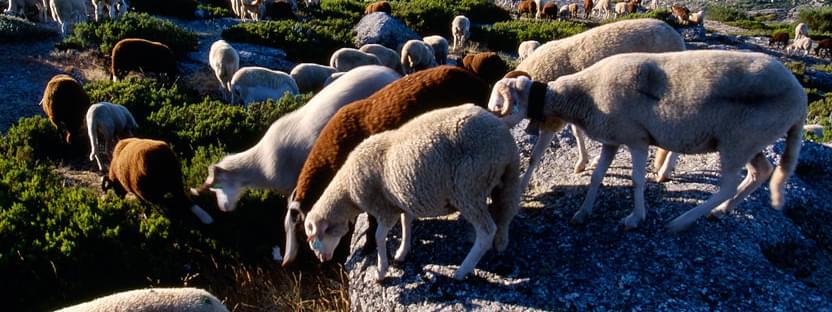The timeless tradition of wool
Wool has been used to protect and provide comfort and has been a part of everyday life since ancient times. Manufacturing and dyeing knowledge, the ponderousness and precision required by production techniques have been preserved and improved throughout hundreds of years. Wool culture is inseparable from herding and the ancient knowledge of agro-pastoral societies. It is connected with the memory of great flocks crossing the mountains, guided by men who strolled through inhospitable territories and isolated mountain villages where people made a living out of ancient weaving traditions.
Transhumance in the Iberian Peninsula
Since ancient times, the border regions of Central Portugal and a part of the Spanish Extremadura have been especially connected with Transhumance in the Iberian Peninsula. Serra da Estrela’s unique characteristics have always allowed it to be an important meeting point in the seasonal flock paths within the peninsular area and this advantageous situation enabled many mountain towns to specialize in herding related arts such as wool manufacturing which made constant progress throughout the years.
In reality, the mountain’s rich pastures attracted many seasonal migration flocks which provided this region in the Portuguese border with abundant raw material to wool manufacturing. Thus, throughout Portuguese History, Serra da Estrela has been the basis of a true wool manufacturing industry which made constant progress.
Wool routes
Wool routes were formed because of the paths shepherds and their flocks would follow and the places wool fabrics would be manufactured. These paths have been documented in national territory ever since the 13th century. Nowadays, it is possible to recreate precisely the route formed by countless paths which made the central region of the country one of the most developed when it comes to economic and social relations with other peninsular lands, even though this is considered one of the most isolated lands in the country.
During the late 20th century, the Council of Europe carefully analysed continental cultural paths and suggested an approach which invites tourists to explore “real or imaginary paths in which (…) European identity is forged”. Among the paths of ancient Europe, the land route which connected the Beira Interior region in Portugal to the Tajo-Salor-Almonte region in Spain because of transhumance and wool trade, stood out.
Since medieval times, the Wool Route, a historical route full of traditions, knowledge and the culture of the inhabitants and interior lands of the Peninsula, has united Spanish and Portuguese mountains, shepherds and weavers, manufacturers and traders. This route recreates the paths followed by wool traders who, during the 16th century and early 20th century between Malpartida de Cáceres, where they would buy Spanish Merino wool, and Covilhã, where they sold it to wool factories.
We invite you to follow this Wool Route which recreates medieval paths and trade traditions between Beira and Extremadura.
Wool Route – TRANSLANA
In 2007 a cross-border project to study and interpret these ancient routes was started. Coordinated by the Wool Museum of Beira Interior, this was an important and deep study of the wool routes of the Portuguese Beira Interior regions which include the municipalities of Castelo Branco and Guarda as well as a part of the Spanish Extremadura, namely the Tajo-Salor-Almonte region, and it allowed the identification of one thousand historically, culturally and anthropologically interesting locations to the History of wool. Above all, it has recreated a route made of landscapes, knowledge and traditions which expand through paths stretching beyond what memory can reach at the heart of the Iberian Peninsula.
There are two museums marking the beginning and the end of the Wool Route. Starting in the Spanish side of the border, the route leaves Lavadero de Lanas de los Barruecos in Malpartida de Cácered, where the Vostell-Malpartida Museum is currently located. Ever since the 18th century, this has been the place where sheep shearing was performed in flocks that passed through during spring on their way to Northern pastures. It was also here that Merina wool would be washed and collected during seasonal campaigns. Strongly connected with wool manufacturing before the industrialization of Cáceres, this large building supplied many regions in Europe and it was here that mule drivers and wool traders would meet seasonally to acquire raw materials for Covilhã factories.
Starting from this complex, we are able to recreate the route taken by these men in ancient times. They would cross the low lands of Spanish Extremadura, follow the Portuguese mountain roads, cross Idanha, Penamacor and Fundão and finally end their commercial route at the Covilhã factories. The Wool Route ends at the old Veiga Royal Factory which is currently the Wool Museum. It is an evidence of how historically important the economic centre of Beira Interior truly is.
Wool Route – History made of strings
A thorough research conducted by the Wool Route project in both sides of the central Peninsula border led to the publication of three volumes which include research documents, photographs, identification and catalogue of over 300 factories dependent on this route, over 100 transhumance paths and around 700 independent heritage evidences related to traditions within this route such as drinking fountains, water tanks, cattle breeding spaces, seasonal shelters, etc.
The Wool Museum in Covilhã will give you information, maps and leaflets regarding the Wool Route, so that you can discover the lands in the regions through traditions and knowledge of a timeless activity.
Retrace the History of Beira; the Wool Route is waiting for you!




